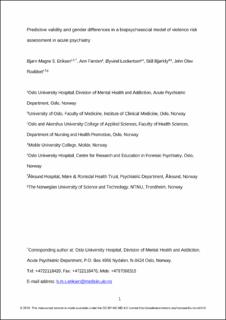| dc.contributor.author | Eriksen, Bjørn Magne Sundsbø | |
| dc.contributor.author | Færden, Ann | |
| dc.contributor.author | Lockertsen, Øyvind | |
| dc.contributor.author | Bjørkly, Stål | |
| dc.contributor.author | Roaldset, John Olav | |
| dc.date.accessioned | 2022-11-02T10:41:18Z | |
| dc.date.available | 2022-11-02T10:41:18Z | |
| dc.date.created | 2018-04-25T09:46:09Z | |
| dc.date.issued | 2018 | |
| dc.identifier.citation | Psychiatry Research. 2018, 264 (June), 270-280. | en_US |
| dc.identifier.issn | 0165-1781 | |
| dc.identifier.uri | https://hdl.handle.net/11250/3029557 | |
| dc.description.abstract | Current violence risk assessment methods seem to have reached an upper limit of accuracy. More comprehensive biopsychosocial models may improve on existing methods. Research on gender differences concerning risk factors of violence is scarce and inconclusive. In this prospective study from an acute psychiatric ward, all patients admitted from March 2012 to March 2013 were included. Predictive validity and potential gender differences in a biopsychosocial model of violence risk assessment consisting of a psychosocial checklist (Violence risk screening-10, V-RISK-10), a patient's self-report risk scale (SRS), total cholesterol (TC) and highdensity lipoprotein cholesterol (HDL) were examined in an inpatient (N=348) and a 3-months follow-up (N=101) sample. Overall increases in explained variances and predictive values were small and non-significant compared to V-RISK-10 alone. In the inpatient sample, HDL contributed significantly to the model for men but not for women. In the follow-up sample, SRS contributed significantly for the whole sample. Results indicated that the biopsychosocial model we tested partially improved accuracy of violence risk assessments in acute psychiatry and that gender differences may exist. Keywords: acute psychiatry, total cholesterol, HDL, self-report, V-RISK-10, biomarkers, screening tools | en_US |
| dc.language.iso | eng | en_US |
| dc.rights | Attribution-NonCommercial-NoDerivatives 4.0 Internasjonal | * |
| dc.rights.uri | http://creativecommons.org/licenses/by-nc-nd/4.0/deed.no | * |
| dc.title | Predictive validity and gender differences in a biopsychosocial model of violence risk assessment in acute psychiatry | en_US |
| dc.type | Peer reviewed | en_US |
| dc.type | Journal article | en_US |
| dc.description.version | acceptedVersion | en_US |
| dc.source.pagenumber | 270-280 | en_US |
| dc.source.volume | 264 | en_US |
| dc.source.journal | Psychiatry Research | en_US |
| dc.source.issue | June | en_US |
| dc.identifier.doi | 10.1016/j.psychres.2018.04.021 | |
| dc.identifier.cristin | 1581486 | |
| cristin.unitcode | 211,2,0,0 | |
| cristin.unitname | Avdeling for helse- og sosialfag | |
| cristin.ispublished | true | |
| cristin.fulltext | original | |
| cristin.fulltext | postprint | |
| cristin.qualitycode | 1 | |

